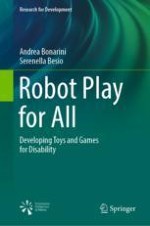2022 | OriginalPaper | Buchkapitel
3. Play and Disabilities
verfasst von : Serenella Besio
Erschienen in: Robot Play for All
Aktivieren Sie unsere intelligente Suche, um passende Fachinhalte oder Patente zu finden.
Wählen Sie Textabschnitte aus um mit Künstlicher Intelligenz passenden Patente zu finden. powered by
Markieren Sie Textabschnitte, um KI-gestützt weitere passende Inhalte zu finden. powered by
